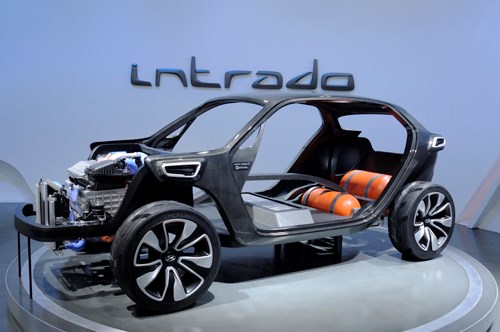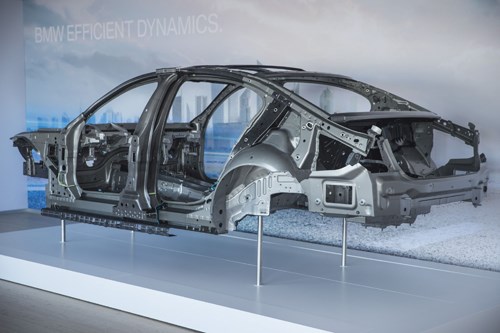Carbon fiber migrating into other vehicles
With the Hyundai Intrado and BMW 7 Series, carbon fiber appears poised to migrate even further into automotive structural applications.

The Hyundai Intrado hydrogen-powered crossover is a concept for now, but uses a carbon fiber passenger cell developed and manufactured by Axon Automotive.
Following the introduction of the carbon fiber-intensive BMW i3 and i8, the big question was, “What’s next?” Each automaker is taking a different tack in its composites integration, and there are some new signs of carbon fiber use in two new cars, one a concept and the other in production.
The concept car is the hydrogen-powered Hyundai Intrado crossover, introduced in 2014. It wasn’t until this year, however, that we learned more about the materials used to fabricate the vehicle’s passenger cell. Fabrication is provided by Axon Automotive (Wollaston, UK), which is well-known for its space-frame composite structures, manufactured using the company’s Axontex system. This employs braided tubes, which are infused to the desired cross-section shape over a low-density polyethylene (LDPE) foam core, which expands during infusion to provide compression against the mold.
The Axontex system for the Intrado uses Hyosung (Seoul, South Korea) Tansome H2550-12K high-strength carbon fiber vacuum infused with Scott Bader’s (Wollaston, UK) Crestapol 1250LV acrylic thermoset resin. The passenger cell also uses Scott Bader’s Crestabond adhesive to bond composite, aluminum and steel parts.
For vehicles, says Axon, its Axontex system allows structures to be optimized to place material where it is needed most. Further, the hollow components help save weight. Axon says it has developed and patented a high-volume manufacturing process for the production of Axontex parts and has been manufacturing passenger cells for Hyundai as the carmaker considers production plans. What’s unknown is when Hyundai might put the Intrado into production.

The 2016 BMW 7 Series uses carbon fiber supplied by SGL Automotive Carbon Fibers, which also manufactures material for the i3 and i8. The 7 Series is a hybrid of several materials, including composites, steel and aluminum.
The second vehicle, which is in production and will enter the market, actually comes from BMW. The 2016 7 Series, like the i3 and i8, uses carbon fiber supplied from SGL Automotive Carbon Fibers (SGL ACF, Moses Lake, WA) in a manufacturing process SGL calls Carbon Core. This appears to combine carbon fiber with other non-composite materials, including steel and aluminum. As a result, the new 7 Series is as much as 130 kg lighter than the 2015 version.
The 7 Series car will be at the 2015 International Motor Show in Frankfurt, Germany, Sept. 17-37.
Related Content
-
Creating a composite battery insert-stud solution for EV trucks
Bossard worked with an OEM and Tier supplier team to meet tight electrical insulation and packaging tolerances while reducing tooling, molding and assembly costs.
-
McLaren develops aerospace-inspired ART method for volume composite super car engineering
Automated rapid tape (ART) technique, already deployed at the MCTC and to be used for future McLaren models, is capable of producing lighter, stiffer and stronger carbon fiber structures with less waste.
-
Infinite Composites: Type V tanks for space, hydrogen, automotive and more
After a decade of proving its linerless, weight-saving composite tanks with NASA and more than 30 aerospace companies, this CryoSphere pioneer is scaling for growth in commercial space and sustainable transportation on Earth.






